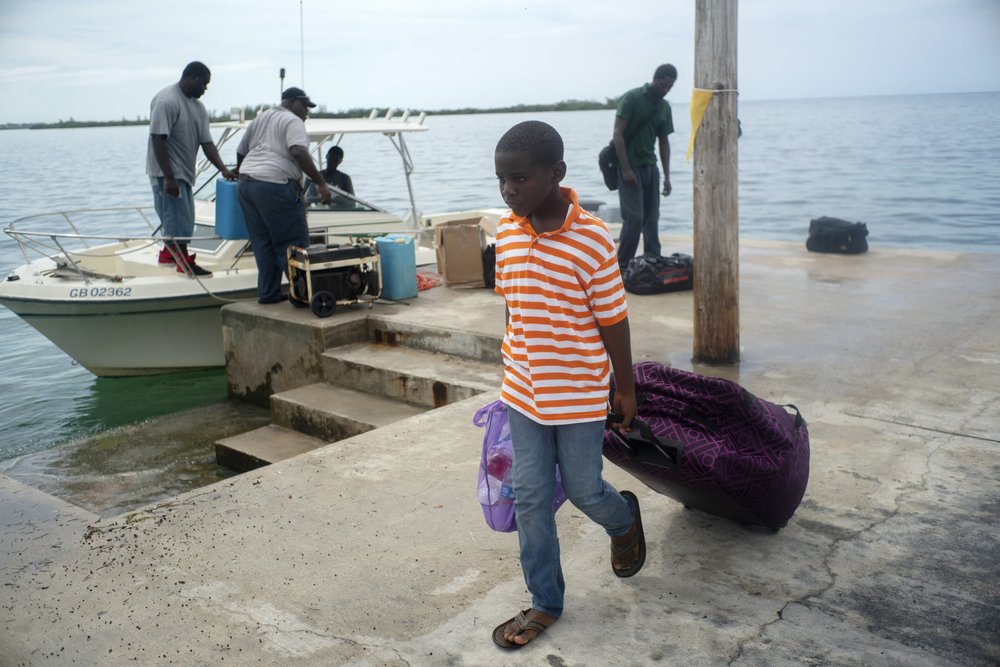Hurricane Dorian shut down some hotels and forced some evacuations Saturday in the northern Bahamas as the fierce Category 4 storm prepared to unleash torrents of rain and howling winds but was projected to spin farther away from the coast of the Southeast U.S. next week.
Forecasters expect Dorian, packing 150 mph (240 kph) winds, to hit the northwestern Bahamas on Sunday before curving upward. The storm’s march north could spare the U.S. a direct hit but still threatens Florida, Georgia and the Carolinas with powerful winds and rising ocean water that causes potentially deadly flooding.
In the northern Bahamas, tourists were sent to government shelters in schools, churches and other buildings offering protection from the storm while residents were evacuating.
“My home is all battened up, and I’m preparing right now to leave in a couple of minutes. … We’re not taking no chances,” said Margaret Bassett, 55, a ferry boat driver for the Deep Water Cay resort who chose to leave her home. “They said evacuate, you have to evacuate. It’s for the best interests of the people.”
Over two or three days, the hurricane could dump as much as 4 feet (1 meter) of rain, unleash devastating winds and whip up an abnormal and dangerous rise in sea level called storm surge, according to private meteorologist Ryan Maue and some of the most reliable computer models.
Bahamas Prime Minister Hubert Minnis warned that Dorian is a “devastating, dangerous storm.”
In the northern Bahamas, small skiffs rented by authorities ran back and forth between outlying fishing communities and McLean’s Town, a settlement of a few dozen homes on the eastern end of Grand Bahama, about 150 miles (240 kilometers) from Florida’s Atlantic coast.
Most were coming from Sweeting Cay, a fishing town of a few hundred people that’s about 5 feet (1.5 meters) above sea level and was expected to be left completely underwater.
A few fishermen planned to stay, which could put them in extreme danger.
“Hoping for the best, that the storm passes and everybody is safe until we return home,” fisherman Tyrone Mitchell said.
Jeffrey Allen, who lives in the city of Freeport on Grand Bahama, said he’s learned after several storms that sometimes predictions don’t materialize, but it’s wise to take precautions.
“It’s almost as if you wait with anticipation, hoping that it’s never as bad as they say it will be, however, you prepare for the worst nonetheless,” he said.
Barbara Carey, who owns a tourist company in the capital of Nassau, said that things were quiet there as the storm tracked farther north but that people were still stocking up on supplies.
The storm-prone Bahamas on average takes a direct hit from a hurricane every four years, officials say.
Construction codes require homes to have metal reinforcements for roof beams to withstand winds into the upper limits of a Category 4 hurricane, and compliance is generally tight for residents who can afford it. Poorer communities typically have wooden homes and are generally lower-lying, placing them at tremendous risk.
After walloping the northern Bahamas, Dorian was expected to dance up the Southeast coastline, staying just off the shores of Florida and Georgia on Tuesday and Wednesday before skirting South Carolina and North Carolina on Thursday.
South Carolina Gov. Henry McMaster declared a state of emergency Saturday, mobilizing state resources to prepare for potential storm effects. President Donald Trump already declared a state of emergency in Florida and authorized the Federal Emergency Management Agency to coordinate disaster-relief efforts.
The National Hurricane Center in Miami stressed that Dorian could still hit Florida, where millions of people have been in the storm’s changing potential path. But after days of predictions that put the state in the center of expected landfalls, the hurricane’s turn northeast is significant.
Carmen Segura, 32, said she had installed hurricane shutters at her house in Miami, bought extra gas and secured water and food for at least three days. She feels well prepared and less worried given the latest forecasts but still uneasy given the storm’s unpredictability.
“Part of me still feels like: So, now what?” Segura said.
Florida Gov. Ron DeSantis and federal officials warned people not to let their guard down.
“Looking at these forecasts, a bump in one direction or the other could have really significant ramifications in terms of impact,” DeSantis said.
David Bibo of FEMA echoed the call to stay vigilant as the storm becomes “a long-duration nail-biter for folks throughout the southeastern United States.”
The storm upended some Labor Day weekend plans: Major airlines allowed travelers to change their reservations without fees, big cruise lines began rerouting their ships and Cumberland Island National Seashore off Georgia closed to visitors.
Disney World and Orlando’s other resorts held off announcing any closings, with Dorian days away and its track uncertain.
Sherry Atkinson, who manages a hotel on North Carolina’s Outer Banks, said the hurricane wasn’t spoiling holiday vacations for guests and “so far, there hasn’t even been a snippet of conversation about evacuations.”
Some counties in Florida told residents of barrier islands, mobile homes and low-lying areas to expect to flee in the coming days.
Dorian was centered 385 miles (625 kilometers) east of West Palm Beach and was moving west at 8 mph (13 kph). A portion of Florida’s east coast was placed under a tropical storm watch Saturday, with winds of 39 to 73 mph (63 to 118 kph) possible within two days.
Some islands in the Bahamas remained under a hurricane warning, with winds of 74 mph (119 kph) or greater expected.
“We ask for God’s guidance and for God to assist us through this,” Prime Minister Minnis said.
(AP)











